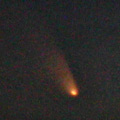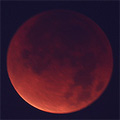
Comet PANSTARRS

ISS Solar Transit

Annular Solar Eclipse

M51 - The Whirlpool Galaxy

M13

Jupiter... and friend

Milky Way Widefield

M8 - The Lagoon Nebula

M101 - The Pinwheel Galaxy

Double Iridium Flare

Lunar Eclipse

Albireo
 Earth/Moon Terrestrial, satellites, meteors, aurora, & the moon |
 Solar System & The Milky Way Planets, comets, star trails, stars, solar, and widefield views of our galaxy |
 Clusters Open & globular clusters |
 Nebulae Emmission, reflection & planetary nebulae |
 Galaxies Objects outside the Milky Way |
 Messier Messier's list of objects |
I observe and photograph the night sky primarily from my home in Northern Utah, USA. The skies are quite dark and with a short drive I can be away from nearly all light pollution. I photography the stars just for fun. I've always been fascinated with astronomy and have just recently purchased my first telescope and began imaging. Astrophotography provides me a way to record the beautiful objects I observe in the sky so they can be observed at any time, night or day. If you have any questions, please contact me.

Celestron C8N-GT
- 8" f/5 (1000mm/200mm) Newtonian reflector
- ASGT (CG-5) equatorial mount
- JMI NGF-DX3 focuser (with 2" extension tube to reach visual focus)

Orion Short Tube 80
- Primarily used as a guide scope for the 8" Newt
- 80mm f/5 achromat refractor
- Mounted on the Newt with Orion 105mm
Guide Scope Rings and Orion Guide Scope Ring Mounting Bar

Canon T2i/D550
- 18.0 megapixel digital SLR camera
- Attached to telescope focuser with Opteka T-Mount adapter

Celestron NexImage
- Dedicated CCD color imager
- Primarily used for autoguiding and moon photos
- Attaches to ST80 and is pointed at a bright star. The image is transmitted
to Guidedog, which sends guiding messages to the AS-GT mount to keep the star
centered. This allows much higher accuracy and longer exposures than would be
allowed if the mount ran by itself.
- IRIS & Photoshop for
image processing
- K3CCD
Tools for video aquisition with NexImage
- NeatImage for cleaning up noisy
images
- Guidedog for autoguiding
- Registax 3 for processing lunar/planetary images
- Carte du Ciel sky mapping software
- Virtual Moon Atlas moon mapping software
- Celestia solar system simulator
- Orbiter for going to the stars myself
Eyepieces: Celestron Ultima (30mm, 12.5mm, 7.5mm, and 2X Barlow), Orion 5mm Illuminate Ultrascopic (for manual guiding and drift alignment), Orion 5mm Ultrascopic (not illuminated for planetary observing on rare, perfectly clear nights), a 20mm Plossl, a Sirius 26mm Plossl, and a few others.
Optical accessories: Orion Variable Polarizing Filter (best thing ever for moon observing), 45° correct image diagonal, 90° Meade prism diagonal.
Odds & Ends: Orion LaserMate Deluxe Telescope Laser Collimator, Celestron A/C adapter (part #18773), Celestron night vision led flashlight, Celestron serial to RS-232 cable (for autoguiding).
Multi-Purpose Coma Corrector, Ha modified Canon DSLR.